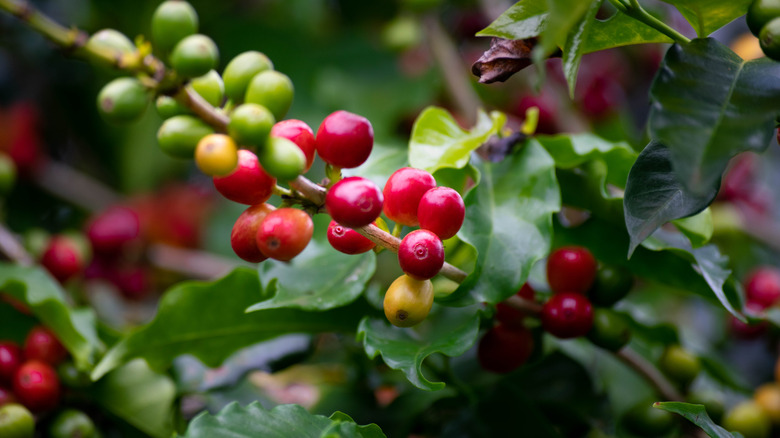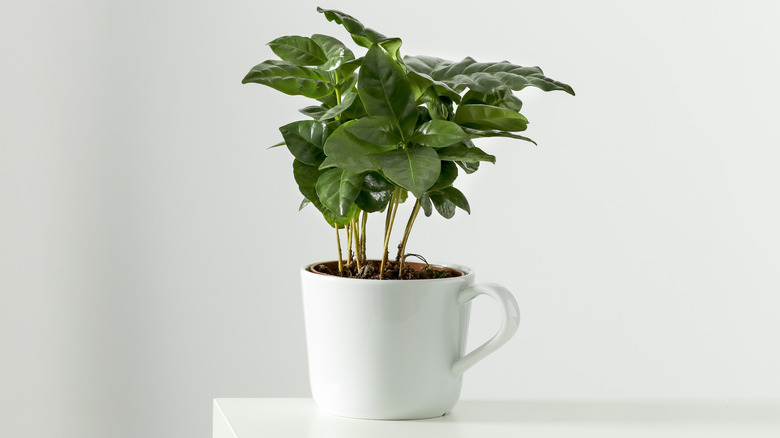The Best Spot To Grow A Coffee Plant In Your Home Or Garden
We may receive a commission on purchases made from links.
If you're looking for an easy houseplant that's beautiful year-round, a coffee plant may be perfect for you. While coffee plants are native to humid, mountainous regions, like Ethiopia, they can thrive in a home as well. Coffee plants like bright but indirect sunlight, so one of the best spots to grow them indoors would be near a sunny window (if left in direct sunlight, the plant's leaves can become burnt and brown). These plants also need higher levels of humidity, which can be achieved by misting, and they do best in temperatures between 65 and 80 degrees Fahrenheit.
If you live in a warmer location, like Hawaii, Puerto Rico, Florida, or California, you may be able to grow coffee plants outside. So long as you make sure temperatures won't drop too low, the plant gets enough water, and it's partially shaded from the sun, you can add a coffee plant to your garden. Since coffee plants naturally grow beneath a forest canopy, shading them with other plants or trees is a great option and may prove the best spot for them to thrive outdoors.
While growing your own coffee might seem like a delicious, money-saving idea, note that coffee plants take three to five years to mature and bloom flowers, and they will only produce berries (which contain two coffee beans each) if they're pollinated.
How to grow a coffee plant inside
To start growing a coffee plant in your home, you can purchase a small, potted coffee plant from a nursery or big brand store, like The Home Depot, or get your hands on some seeds. When starting with seeds, note it will take a few months for them to germinate. You'll first need to soak your seeds in water for a day; they then can be placed in damp — not soaked — sand. Once they've germinated, you can transfer them to a pot with soil. Coffee plants do better with dense soil, like mixtures that contain peat.
Coffee plants like their soil moist, and will need to be watered about every week, or whenever the top inch of soil is dry. It is important to use a pot with good drainage so the soil doesn't become overly saturated. To keep a coffee plant in your home humid, you can mist it once a day and put a shallow dish with rocks and water beneath the pot. When choosing the best spot in your home for your coffee plant, you'll want to keep the plant away from drafty windows in the winter and air-conditioning vents in the summer. You can also feed your coffee plant with fertilizer every couple of weeks in the spring and summer, but it won't require as much in the winter.
How to prune a coffee plant
If left alone, a coffee plant can grow between 6 and 15 feet tall and wide, but pruning your plant will keep it from overtaking your home and/or garden. While your coffee plant probably won't require a ton of pruning, routine pruning can help to keep it a nice shape and, as said, avoid growing too large. During the springtime when new shoots begin appearing, trim the stems right above a joint. Cutting at a 45-degree angle works best, and it's important not to trim too much at once, as it could send your plant into shock. If do you want your plant to be a bit larger, you can prune it less often.
While you probably won't be able to harvest your coffee plant to brew pots of homegrown coffee, the plant's beautiful, bright green leaves and delicate white flowers will brighten your home inside or your garden outside. And, if you do choose to pollinate your coffee plant, you may eventually end up with a few beans you can try roasting.


